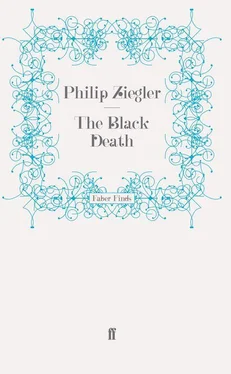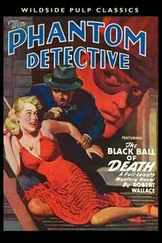Not unreasonably, Pope Clement VI calculated that nothing would be gained by his death and that, indeed, it was his duty to his people to cherish them as long as possible. He therefore made it his business to stay alive. On the advice of the papal physician, Gui de Chauliac, he retreated to his chamber, saw nobody, and spent all day and night sheltering between two enormous fires. For a time he took refuge in his castle on the Rhône near Valence but by the autumn he was again at his post in Avignon. It does not seem that the Black Death died out in the papal capital much before the end of 1348.
* * *
‘Fish, even sea fish, are commonly not eaten’ the horrified clerics of Bruges heard from their compatriots at Avignon, ‘as people say that they have been infected by the bad air. Moreover, people do not eat, nor even touch spices, which have not been kept a year, since they fear that they may have lately arrived in the aforesaid ships. And, indeed, it has many times been observed that those who have eaten these new spices and even some kinds of sea fish have suddenly been taken ill.’
As the Black Death moved across Europe it was inevitable that a host of theories would be generated on the best methods of avoiding, preventing and curing the disease. The growing threat to France induced King Philip VI to appeal to the Medical Faculty at Paris to prepare a considered report on the subject. Their response {121} 121 17 op. cit., p.38, n.24 above.
provided the most prestigious, though neither the best informed nor the most intelligent, of the many studies of the Black Death in action. The plague literature as a whole, drawn from some half-dozen countries, was voluminous, repetitious and of little value to the unfortunate victims of the epidemic. Before considering it, however, it is worth taking a quick look at the growth of medical knowledge before and during the Middle Ages so that the disadvantages and limitations under which the medieval physician laboured can be better understood.
Modern medical science, if a gross over-generalization may be forgiven, began with Hippocrates. It was he who first conceived ill health, not as a series of unrelated and essentially inexplicable catastrophes but as an orderly process calling on each occasion for examination of symptoms, diagnosis of malady and prescription of cure. For any study of the Black Death his importance is paramount since he was the first student of epidemiology and the first to distinguish between epidemic and endemic diseases. In his First and Third Books of Epidemics and the four volumes of notes compiled either by Hippocrates himself or by his son he set out to analyse the factors which led to a disease settling in any given area and becoming endemic. The next stage was to define and explain the causes, climatic, meteorological or latent within the body of man himself, which provoked a subsequent epidemic outburst. It was his particular concern to work out a relationhip between each type of epidemic and the different environmental conditions in which it flourished. This ‘katastasis’, as he called it, was, it seemed to him, best established on astronomical evidence – a red herring which Hippocrates himself might in time have transcended but which was to bedevil medical research for many centuries.
The main flaw in the monumental labour of Hippocrates was that he had insufficient data from which to draw valid conclusions. He deduced, for instance, that spells of warm, moist weather were, in themselves, conducive to ill health; a thesis reasonable enough where malarial regions were concerned but irrelevant if not positively misleading when applied to England. His great achievement was to have provided a blue-print for research on which subsequent generations should have worked. The tragedy is that the vast compilation of case histories, on which a serious study of epidemiology could alone have been based, was not made by his successors. After the death of Hippocrates in 377 BC, medical science slumbered for five hundred years; it awoke only to find itself rigidified by the misplaced formalizing genius of Galen of Pergamos.
Galen was one of the outstanding intellects of his age and a great experimental physiologist. But, when it came to epidemiology, rather than work from the Hippocratic base and accumulate fresh data from which empirically to establish new and constructive theses, he instead elected to devise an inflexible theoretical pattern which left no room for further research or original thought. He lived through a major epidemic of bubonic plague but the phenomenon was in no way reflected in his work. To attempt to summarize Galen’s complicated and, within his own terms of reference, logically faultless theorizing would be to reduce it to a parody. Suffice it to say that he believed ill health to depend on the interaction of temperament, the constitution of the atmosphere and certain other factors such as excessive or ill-judged eating and drinking. Temperament and constitution in their turn depended on the blending of the elementary qualities and any failure to achieve perfect balance led to one of a number of possible discords. The permutations on these factors were developed into an intricate mathematical pattern: a computer into which the details of any case could be fed and a logically satisfactory explanation provided.
Unfortunately, though the logic might be impeccable, its relevance to anything so mundane as the prevention or cure of plague was sadly tenuous. What was worse, the medieval physician believed that Galen had said the last word on epidemics and that any further research was unnecessary if not positively disrespectful to the teachings of the master. And yet the teachings of the master themselves were in doubt since the original texts had been largely lost and doctors in the West for several centuries worked almost exclusively from inadequate Latin versions of Arabic translations of Hippocrates and Galen. The result was an Arabic-Latin literature, in Dr Singer’s description,
…generally characterized by the qualities most often associated with the words ‘medieval’ and ‘scholastic’. It is extremely verbose and almost wholly devoid of the literary graces. An immense amount of attention is paid to the mere arrangement of the material, which often occupies its author more than the ideas that are to be conveyed. Great stress is laid on argument, especially in the form of syllogism, while observation of nature is entirely in the background…. Lip-service is often paid to Hippocrates, but his spirit is absent from these windy discussions. {122} 122 18 C. Singer, Short History of Medicine, p. 69.
Nurtured on such material it is hardly surprising that medical science did not flourish in the Middle Ages. ‘The Dark Ages for Medicine,’ wrote Dr Singer, ‘began at the death of Bede in 753’. {123} 123 19 C. Singer, ‘Review of the Medical Literature of the Dark Ages’, Proc. Roy. Soc. Med., Vol. X, 1917, p. 107.
They did not end until long after the Black Death had run its course. But the failings of the fourteenth-century doctors should not be exaggerated nor their limitations presented as grotesque extravagances. Ill-informed and unimaginative they might have been but there was, on the whole, surprisingly little of the:
Watres rubifiying, and boles galle,
Arsenyk, sal armonyak, and brymstoon,
And herbes koude I telle eek many oon,
As egremoyne, valerian, and lunarie. [1] For this and subsequent extracts from The Canterbury Tales I append as a footnote Professor Coghill’s admirable rendering published by Penguin Books. Water in rubefaction; bullock’s gall, Arsenic, brimstone, sal ammoniac, And herbs that I could mention by the sack, Moonwort, valerian, agrimony and such.
Читать дальше












